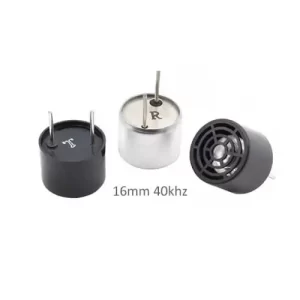Double sheet sensor is a non-contact ultrasonic sensor. We usually use it to detect overlapping thin sheet materials. For example, the double sheet detector switch can check papers, metal foils, plastic films, labels. Or monitor the double feeding of solar wafers, wood plates and PCB circuit board. So it has wide applications in machines, such as printing, folding, lithium battery laminating, labeling and punching, etc.
Detection range of our ultrasonic double sheet sensor for different materials
We have actually tested our double splice sensors. The below table lists the thickness limit data for different blanks.
| Material |
Can Detect |
Can Detect |
Can't Detect |
| Matte Coated Paper |
105 (g) |
4842 (g) |
5052 (g) |
| Silicon Wafer |
0.118mm |
0.44mm |
0.58mm |
| High Precision Iron Piece |
0.05mm |
0.1mm |
0.2mm |
| Copper Piece |
0.05mm |
0.16mm |
0.24mm |
| Plastic Piece |
0.33mm |
1.43mm |
1.9mm |
| Glass Piece |
0.08mm |
0.55mm |
0.7mm |
| Aluminum Piece |
0.2mm |
0.5mm |
0.8mm |
Kind note:
① The data above is for M18 double sheet sensor. If it is M12, the thickest data should be reduced by 20%.
② The data above is based on the V04 program.
③ We obtain the un-measurable value of matte pink paper by this way: paste multiple papers together.
④ We get the un-measurable value of the silicon wafer by this way: paste 0.44mm and 0.13mm silicon wafers together when exposed to water.
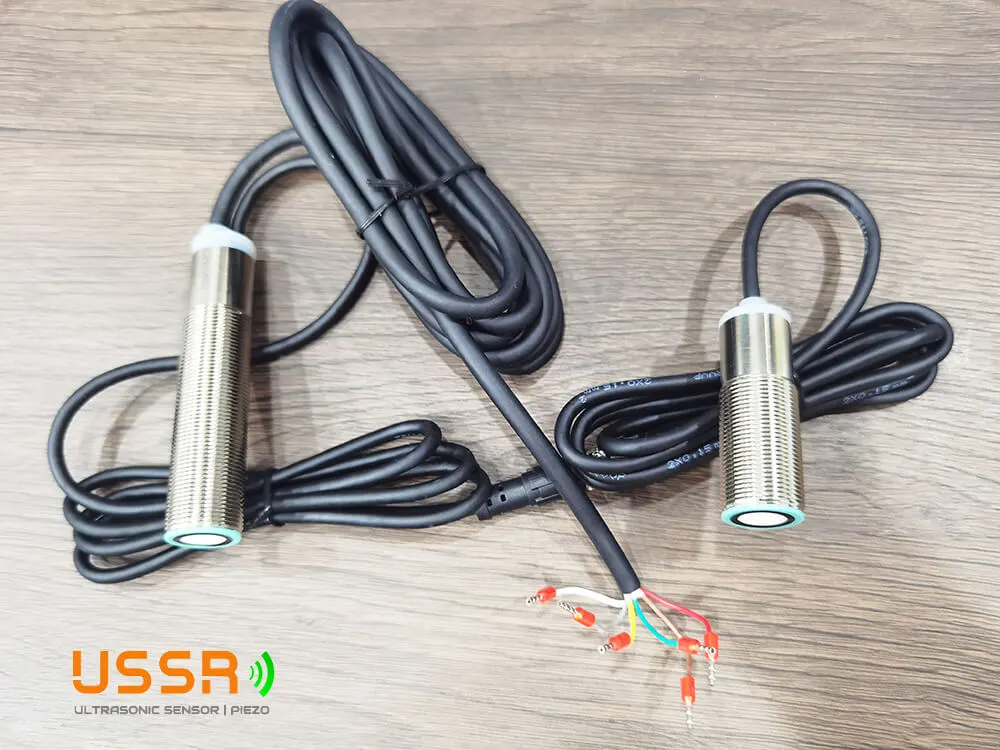
Highlights & Features of USSR Double Blank Detector Sensor
Highlights:
3 NPN/PNP outputs - singlesheet, double sheet, air;
It can change the output mode via serial upgrade;
Strong anti-interference capability - anti-electromagnetic interference;
Realize the learning function for different materials through teach-in cable;
It's with temperature compensation function;
Fast response time (M18): 17ms for single sheet, 17ms for air, 52ms for double sheet;
Various detection range options: 20~60mm, 20~40mm, 20~100mm;.
There is short circuit protection and overload protection;
Basic features:
Detects single sheet and doublesheet of different materials;
Non-contact detection, unaffected by object gloss, reflectivity, colour or transparency.
Quickly differentiate between single and double sheets. Improve production efficiency;
The sensor is with calibration mode;
Simple operation. It can realize automation control;
Common Different Industry Applications
How Does the Double Sheet Detection Sensor Work?
Actually, ultrasonic sensors contain 2 types. One is for distance measurement. The other is for energy measurement. Ultrasonic proximity switch belongs to the former. The double blank sensor belongs to the latter. Besides, it has two parts: the long part is transmitter, and the short part is receiver. What's the working principle?
It belong to the through-beam ultrasonic sensor. The emitter sends a specific frequency ultrasonic wave. They penetrate the target object. During the process, some energy is reflected and absorbed by the target. Finally the remaining energy is received by the receiver. Therefore, we can determine the single and double sheets according to the energy change.
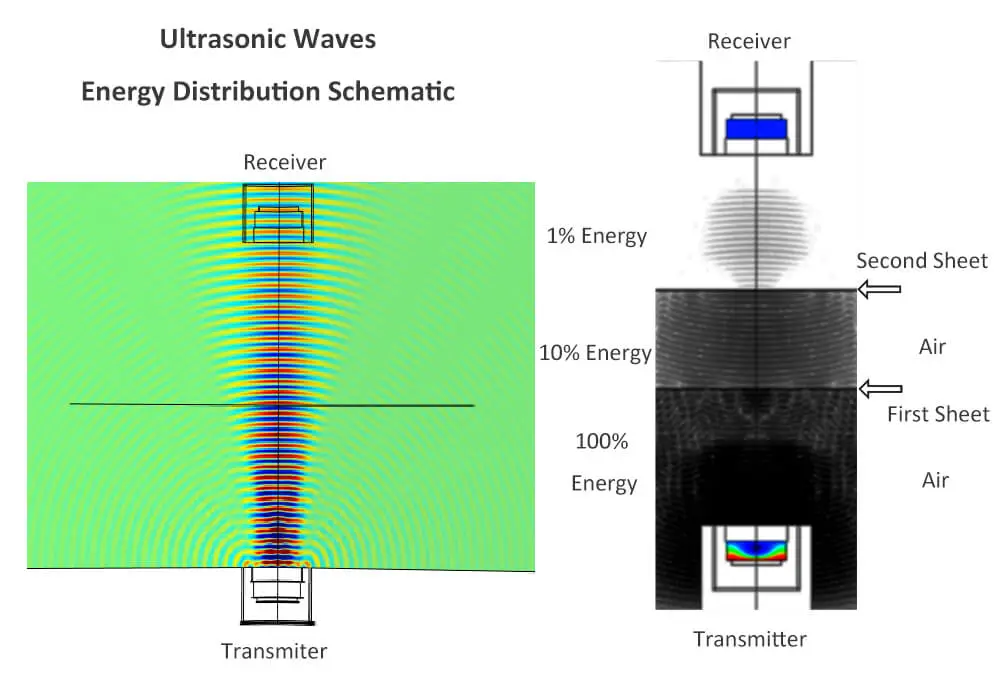
(1) First case: no blank material enters between double sheet sensor. In this case, there is no blocking. All of the emitted energy is received by the receiver. Therefore, we can determine that there is no medium.
(2) Second case: a sheet material enters between two transducers. The object will transmit some of the energy to the receiver. The transmission energy bases on the thickness and density of the object.
The figure shows that the transmission energy is 10% of the emitted energy. At this time, the received energy will be much less than the energy when there is no blocking. However, it can detect the received energy. Then we judge it to be the single sheet.
(3) The third case: double sheet materials enter between the sensor transducers. The ultrasonic waves travel through the air and comes into contact with the first sheet. At this time, the energy is attenuated by 90%. This part of energy will continue travelling. Then it contacts the second sheet. Finally, only 1% of the energy remains. As a result, the receiver receives almost no energy. We judge it as the double sheet.
Working and Teach-in Learning Mode:
Different modes, different displays of the sensor lights. Here we introduce its working mode and teach-in mode.
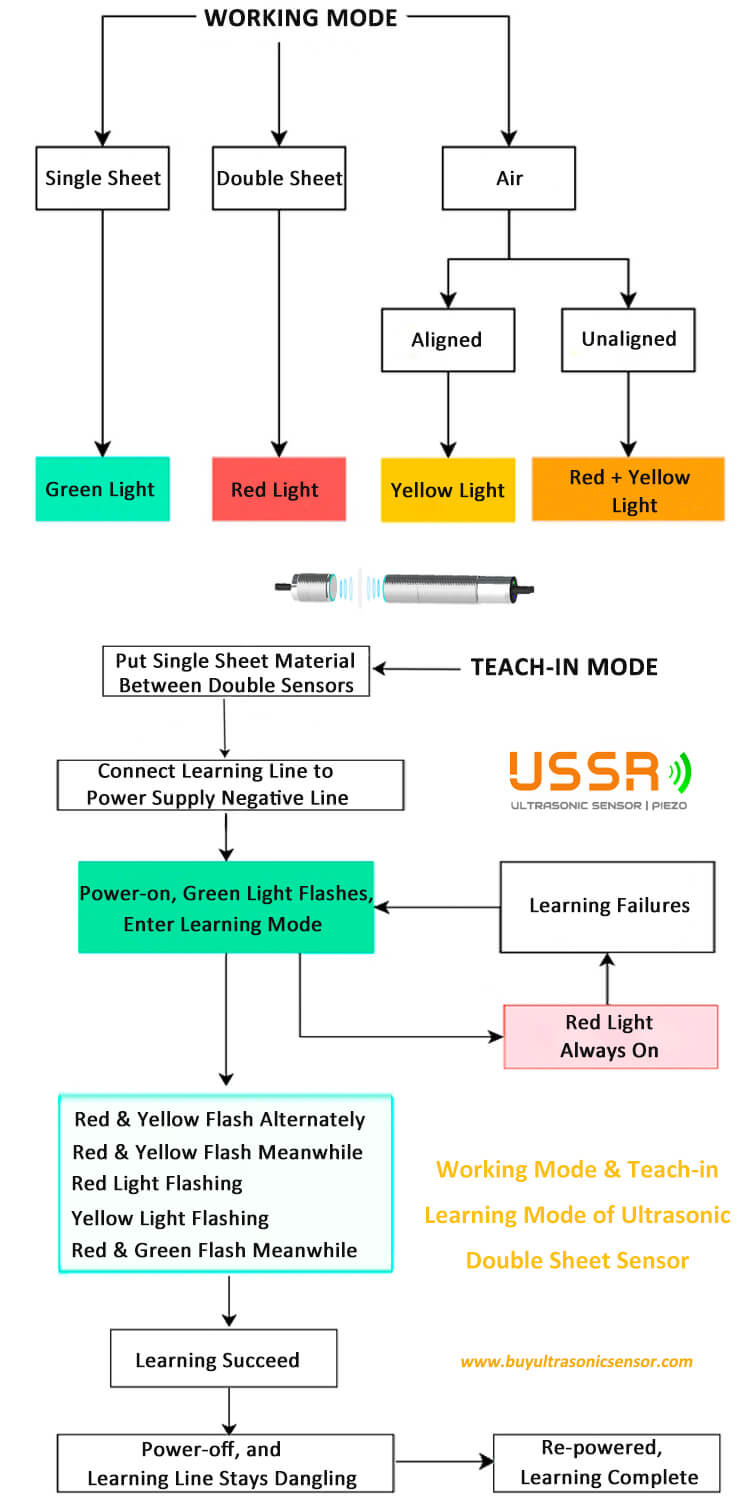
| Light Display of in Working Mode |
| Single Sheet |
Green light on |
| Double Sheet |
Red light on |
| Air |
Yellow light on / red light on (sensors not aligned) |
|
| Light Display of in Teach-in Mode |
| Learning Failure |
Red light on (approx. 2 seconds) |
| Learning Succeed |
Red and yellow light flash alternately (thin material)
Red and yellow flash at the same time
Red light flashing
Yellow light flashing
Red and green flash at the same time (thick material) |
Double blank sensor can detect different sheet materials. But how do we switch to measure these materials. Below are the teach-in steps of the doublesheet sensor:
M18 series sensor:
1. Place a single sheet of tested material between two sensors;
2. Connect the learning line to - UB.
3. Power on and green light will be flashing. When the red and yellow lights flash alternately or simultaneously and when the red light or the yellow light flashes or they flash simultaneously, the learning is completed.
If the learning is not successful, the red light will always light up once,
Then the green light flashes and enters the learning state again.
4. Power off and float the learning line into the air.
5.Normal use.
M12 series sensor:
1. Place a single sheet of the tested object within the detection range and power it on.
2. Short circuit the learning wire (red wire) to the negative electrode (green wire).
3. The green light continues to flash for more than 3 seconds, indicating successful learning (after successful learning, the product will no longer learn.
Learning failure situation: A red light flashing indicates that the measured object is too thick or not connected for emission, while a yellow light flashing indicates that the measured object is not placed or too thin.
When learning fails, the indicator light goes out briefly. Automatic re-learning.)
4. Learning wire overhangs and reapply power. The product works normally.
Why We Need Ultrasonic Double Sheet Detector?
In fact, there are multiple methods of double sheet detection. But each has its own advantages and disadvantages. The following table gives a comparative analysis of them.
| Double Sheet Detection Method |
Working Principle |
Advantage |
Disadvantages |
| Electromechanical Control |
Make the electrical contacts closed by paper thickness. |
Sensitive and reliable |
Complex structure, easy to wear, high installation accuracy requirements |
| Air Suction Detection |
The air sucks single or double sheets. Different feedback force, different paper deformation |
Simple structure |
Highly affected by paper quality. Light paper or static electricity is susceptible. |
| Photoelectric Double Sheet Detection |
The energy of light transmission |
Fast response, low cost |
Affected by material, colour, etc. Difficult to detect opaque material |
| Capacitive Double Sheet Detection |
The capacitance of a flat capacitor varies with the dielectric between the two pole plates |
Unaffected by paper flatness. Insensitive to the colour of the paper |
Sharp drop in sensitivity and reliability for thin paper detection |
| Ultrasonic Double Sheet Inspection |
Ultrasonic Transmission Energy |
Suitable for a variety of materials, opaque materials, transparent materials, etc. |
Ultrasonic wave propagation requires a medium. So it cannot be carried out in a vacuum |
In summary, ultrasonic double-sheet sensors are more applicable. It is suitable for most thin sheet materials. So the double blank detector is the ideal option. Below we explain this point with an example from the photovoltaic industry.
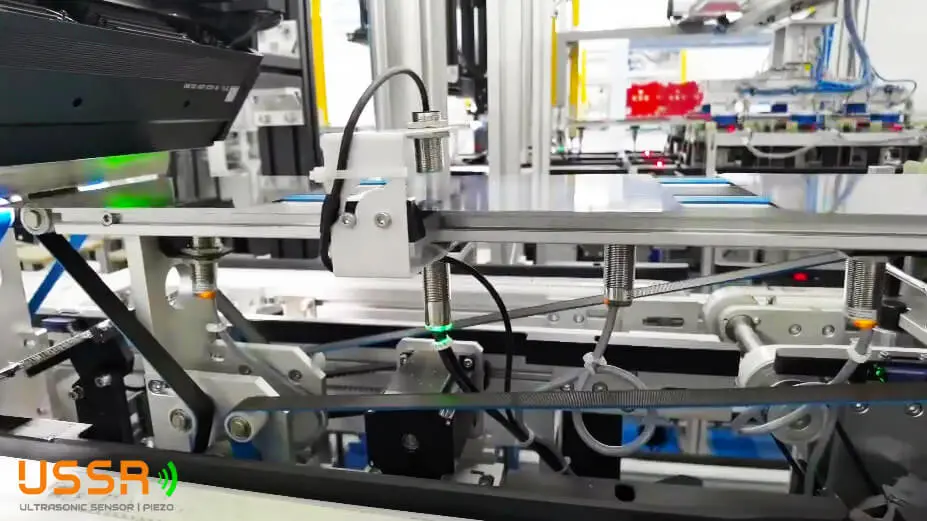
The production of solar cells is highly automated. During the process of turning silicon wafers into silicon cells, it is necessary to go through more than a dozen processes. These include cleaning and flocking, screen printing, testing and sorting and other processes. It is possible that there is a double stacking of silicon wafers. We must find and reject these error states. Otherwise, it may produce defective products in the subsequent processes. Ultimately, it will cause material waste and economic loss. So we need to identify and eliminate double wafer sheets.
The thickness of photovoltaic silicon wafers is thin. Generally it is only 0.18mm. Moreover, the material is brittle and easy to break. In the latter part of the process, the wafer's absorption efficiency of light gradually increases. And the disadvantages of conventional detection methods are obvious:
Contact magnetic scale thickness measurement:
① Need to add extra mechanical structure.
② Easy to damage silicon wafers.
High precision laser thickness measurement:
① The wafer light absorption will increase in the back-end process. So the laser double detection is not stable;
② Sensitive to mechanical vibration of the target. High installation requirements;
③ It requires additional trigger sensors and module interfaces.
Eddy current sensors: unable to measure double sheets of non-metallic materials such as silicon wafers.
Ultrasonic double-sheet detector: It can better solve the problem of detecting single and double sheets of silicon wafers. It is a non-contact detection method. Therefore, it does not damage the silicon wafers. It can simply, stably and reliably output the state of double sheets of solar wafers.
How to install the double sheet detection sensor?
Brown wire is positive;
Red wire is the learning wire;
White wire is the single output;
Yellow wire is double sheet output;
Grey wire is air output;
Green wire is negative;
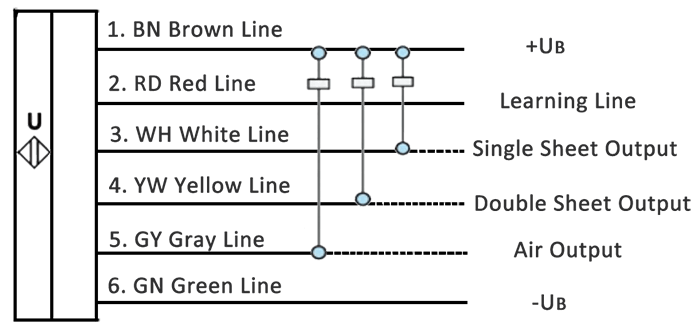
Ultrasonic sensors have directional nature. So it is necessary to pay attention to the installation position. It's good to install the transmitter and receiver in a position where their center axes coincide. So it can get high sensitivity. When installation vertically, please ensure the emitter end face up.
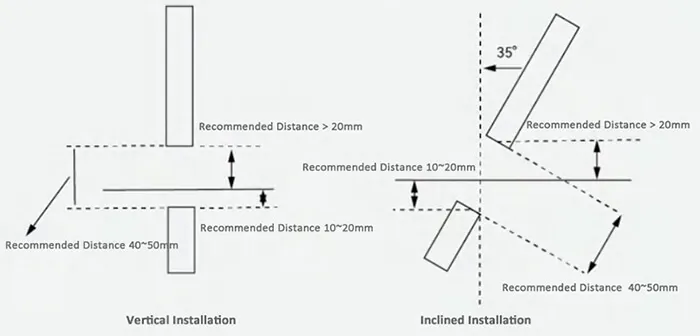
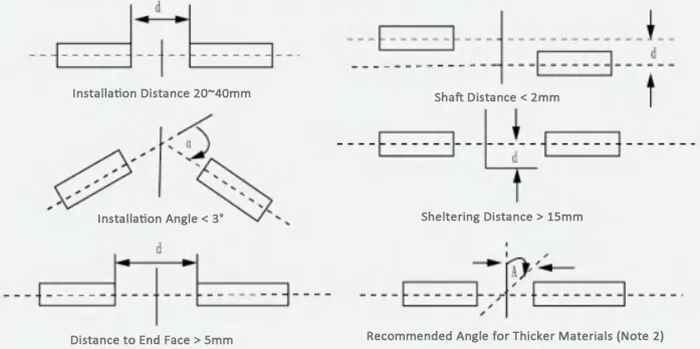
[Note 1] Alignment indication:
If the wheelbase deviation of the product is greater than 2-4mm, or the installation angle deviation is greater than 3-6 °, and the red and yellow lights are on simultaneously under air output, it indicates that the product is not aligned.
[Note 2] Installation angle of ultrasonic double sheet sensor:
If it is corrugated paper, installation angle is less than 35°;
If it is solar cell silicon wafers, it is about 30°;
For the thin metal sheets, Recommended angle is about 27°;
But when install the sensors actually, we need to confirm the optimal installation angle repeatedly by learning.
FAQ
